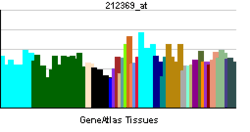ZNF384
Zinc finger protein 384 is a protein that in humans is encoded by the ZNF384 gene.[3][4][5]
Function
This gene encodes a C2H2-type zinc finger protein, which may function as a transcription factor. This gene also contains long CAG trinucleotide repeats that encode consecutive glutamine residues. The protein appears to bind and regulate the promoters of the extracellular matrix genes MMP1, MMP3, MMP7 and COL1A1. Studies in mouse suggest that ZNF384 may be part of a general mechanical pathway that couples cell construction and function during extracellular matrix remodeling. Alternative splicing results in multiple transcript variants.[5]
Clinical significance
Recurrent rearrangements of this gene with the Ewing's sarcoma gene, EWSR1 on chromosome 22, or with the TAF15 gene on chromosome 17, or with the TCF3 (E2A) gene on chromosome 19, have been observed in acute leukemia.[5]
References
- ↑ "Human PubMed Reference:".
- ↑ "Mouse PubMed Reference:".
- ↑ Margolis RL, Abraham MR, Gatchell SB, Li SH, Kidwai AS, Breschel TS, Stine OC, Callahan C, McInnis MG, Ross CA (Jul 1997). "cDNAs with long CAG trinucleotide repeats from human brain". Human Genetics. 100 (1): 114–22. doi:10.1007/s004390050476. PMID 9225980.
- ↑ Thunyakitpisal P, Alvarez M, Tokunaga K, Onyia JE, Hock J, Ohashi N, Feister H, Rhodes SJ, Bidwell JP (Jan 2001). "Cloning and functional analysis of a family of nuclear matrix transcription factors (NP/NMP4) that regulate type I collagen expression in osteoblasts". Journal of Bone and Mineral Research. 16 (1): 10–23. doi:10.1359/jbmr.2001.16.1.10. PMID 11149472.
- 1 2 3 "Entrez Gene: ZNF384 zinc finger protein 384".
Further reading
- Matsuo MY, Asakawa S, Shimizu N, Kimura H, Nonaka M (Feb 2002). "Nucleotide sequence of the MHC class I genomic region of a teleost, the medaka (Oryzias latipes)". Immunogenetics. 53 (10-11): 930–40. doi:10.1007/s00251-001-0427-3. PMID 11862394.
- Graflund M, Sorbe B, Karlsson M (May 2002). "MIB-1, p53, bcl-2, and WAF-1 expression in pelvic lymph nodes and primary tumors in early stage cervical carcinomas: correlation with clinical outcome". International Journal of Oncology. 20 (5): 1041–7. doi:10.3892/ijo.20.5.1041. PMID 11956602.
- Martini A, La Starza R, Janssen H, Bilhou-Nabera C, Corveleyn A, Somers R, Aventin A, Foà R, Hagemeijer A, Mecucci C, Marynen P (Oct 2002). "Recurrent rearrangement of the Ewing's sarcoma gene, EWSR1, or its homologue, TAF15, with the transcription factor CIZ/NMP4 in acute leukemia". Cancer Research. 62 (19): 5408–12. PMID 12359745.
- Suzuki Y, Yamashita R, Shirota M, Sakakibara Y, Chiba J, Mizushima-Sugano J, Nakai K, Sugano S (Sep 2004). "Sequence comparison of human and mouse genes reveals a homologous block structure in the promoter regions". Genome Research. 14 (9): 1711–8. doi:10.1101/gr.2435604. PMC 515316
 . PMID 15342556.
. PMID 15342556.
- La Starza R, Aventin A, Crescenzi B, Gorello P, Specchia G, Cuneo A, Angioni A, Bilhou-Nabera C, Boqué C, Foà R, Uyttebroeck A, Talmant P, Cimino G, Martelli MF, Marynen P, Mecucci C, Hagemeijer A (Sep 2005). "CIZ gene rearrangements in acute leukemia: report of a diagnostic FISH assay and clinical features of nine patients". Leukemia. 19 (9): 1696–9. doi:10.1038/sj.leu.2403842. PMID 15990865.
- Janssen H, Marynen P (Apr 2006). "Interaction partners for human ZNF384/CIZ/NMP4--zyxin as a mediator for p130CAS signaling?". Experimental Cell Research. 312 (7): 1194–204. doi:10.1016/j.yexcr.2006.02.001. PMID 16510139.
External links
This article incorporates text from the United States National Library of Medicine, which is in the public domain.
|
|---|
|
|
|
(2) Zinc finger DNA-binding domains |
|---|
| | (2.1) Nuclear receptor (Cys4) | | subfamily 1 | |
|---|
| | subfamily 2 | |
|---|
| | subfamily 3 | |
|---|
| | subfamily 4 | |
|---|
| | subfamily 5 | |
|---|
| | subfamily 6 | |
|---|
| | subfamily 0 | |
|---|
|
|---|
| | (2.2) Other Cys4 | |
|---|
| | (2.3) Cys2His2 | |
|---|
| | (2.4) Cys6 | |
|---|
| | (2.5) Alternating composition | |
|---|
| | (2.6) WRKY | |
|---|
|
|
|
|
|
| (4) β-Scaffold factors with minor groove contacts |
|---|
| |
|
|
| (0) Other transcription factors |
|---|
| |
|
|
see also transcription factor/coregulator deficiencies |

 . PMID 15342556.
. PMID 15342556.